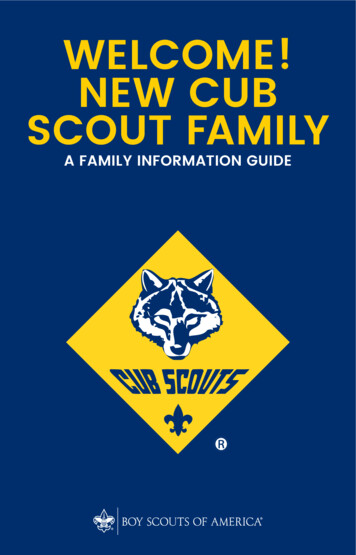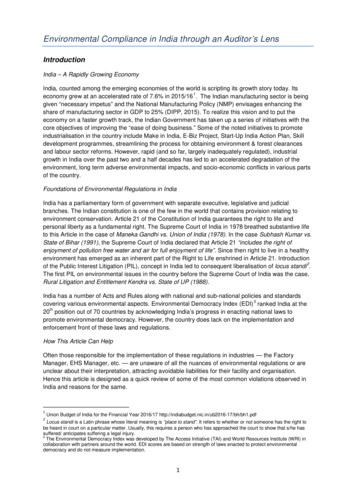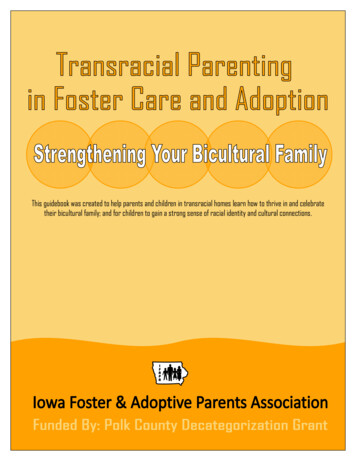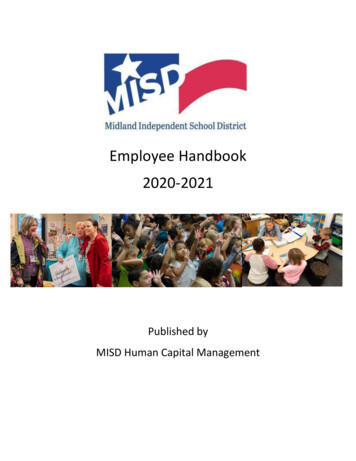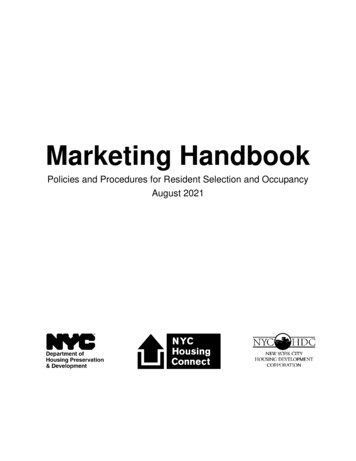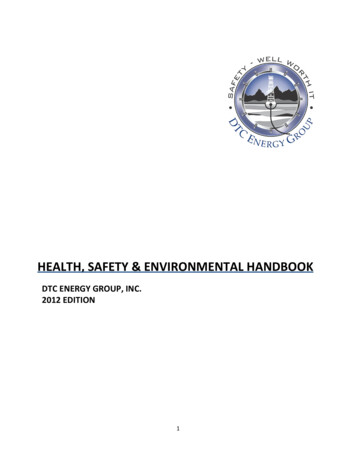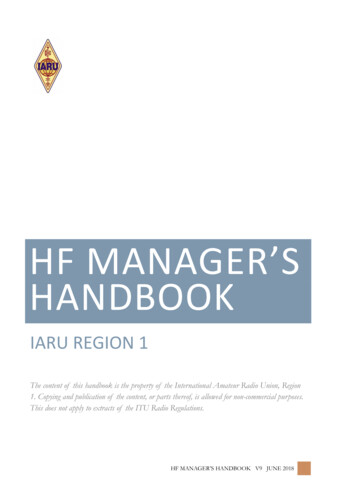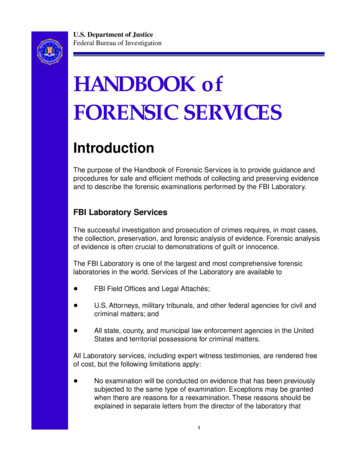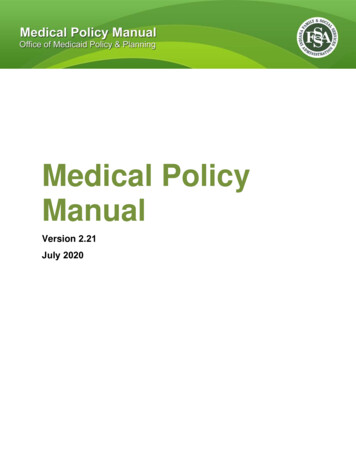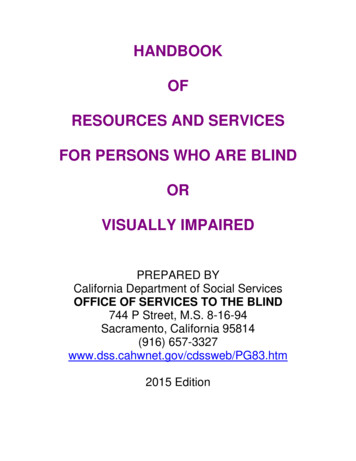
Transcription
HANDBOOKOFRESOURCES AND SERVICESFOR PERSONS WHO ARE BLINDORVISUALLY IMPAIREDPREPARED BYCalifornia Department of Social ServicesOFFICE OF SERVICES TO THE BLIND744 P Street, M.S. 8-16-94Sacramento, California 95814(916) 657-3327www.dss.cahwnet.gov/cdssweb/PG83.htm2015 Edition
TABLE OF CONTENTSI.INTRODUCTION – Pg. 1II.FREQUENTLY ASKED QUESTIONS – Pg. 6III. SERVICES FOR PERSONS WHO ARE BLINDVISUALLY IMPAIRED – Pg. 10IV. OTHER SOCIAL AND SUPPORTIVESERVICES – Pg. 30V. FINANCIAL ASSISTANCE PROGRAMS– Pg. 35VI. MEDICAL ASSISTANCE SERVICES – Pg. 44VII. ORIENTATION AND MOBILITY – Pg. 53VIII. RECREATIONAL OPPORTUNITIES – Pg. 60IX. ASSISTIVE TECHNOLOGY – Pg.X.ORGANIZATIONS AND ASSOCIATIONS – Pg.DIRECTORY OF RESOURCES –Pg.A.CALIFORNIA AGENCIES – Pg.B.LOW VISION SERVICES IN CALIFORNIA – Pg.
C.COUNTY SOCIAL SERVICES OFFICES – Pg.D. CALIFORNIA DEPARTMENT OFREHABILITATION – Pg.E.LARGE PRINT BOOKS – Pg.F.AUDIO BOOKS AND PERIODICALS – Pg.G. RADIO READING SERVICESIN CALIFORNIA – Pg.H. NEWSLETTERS, MAGAZINESAND JOURNALS – Pg.I.CATALOGS OF MERCHANDISE – Pg.J. VENDORS OF ASSISTIVETECHNOLOGY – Pg.DISCLAIMERRevised 2015
I.INTRODUCTIONLosing vision can be extremely traumatic. No onegets this news without having a complex set ofreactions such as denial, anger, fear and depression.If you have recently learned that your vision isdiminished or likely to worsen in the future, you maybe experiencing any or all of these feelings. You maybe wondering how you will go on doing what you havealways done, how you will maintain yourindependence and how you will take care of yourselfand your family.Some people think that because they have diminishedeyesight they are not a full person. You may behaving similar thoughts; you may be feeling veryalone. One of your concerns may be that you don’tknow where to turn for guidance, advice, assistance,support, comfort, information and instruction.We at the Office of Services to the Blind want you toknow that you are not alone. Although only you canmake the adjustment to vision loss for yourself, thereare many services and support systems that can helpyou. This Handbook has been prepared to give youan overview of services available to you and to getyou started on the path to a healthy and positivefuture.1
First, let us spend a few minutes expressing ourthoughts about persons with visual impairments.Blindness does not equal helplessness or despair.Millions of people in the United States who arevisually impaired live happy, healthy and productivelives. They pursue relationships, jobs, hobbies, civicduties, volunteer work, parenting and all the othercomponents of human endeavor with the sameeffectiveness and satisfaction as fully sighted people.With training in the special skills of independence,individuals can accomplish just about anything theyset out to do.Our philosophy is that the essence of a person doesnot reside in the ability to see or to perform anyparticular physical function, but rather in the spirit.The capacity to set the course of one’s own life andthe conviction to stay on course despite the inevitableobstacles of destiny come from the will. If one suchobstacle is the loss of eyesight, it is the inner personwho makes the choice between defeat andadjustment. Thus, the onset of a visual disabilityneed not be a barrier to an individual’s ability to attaina rich and fulfilling life.Blind and visually impaired individuals are an integralpart of our society. They are employees,breadwinners, spouses, parents and grandparents.They care about the same life functions as everyoneelse: earning a living, raising a family, being2
personally fulfilled and making a contribution toothers.The most dangerous thing that you can do at thispoint is make assumptions about what you will or willnot be able to do in the future. You are probably notfamiliar enough with the implications of visualimpairment to fully know what to expect. Please seekthe support and guidance of persons who areknowledgeable. People who have experienced visionloss, as well as professionals trained to assistpersons with visual impairments, can be oftremendous help to you in this transition phase.Before you make any major life decisions such asquitting a job, selling a house, moving in with adultchildren or others, abandoning hobbies or friends,please contact an agency providing servicesspecifically for visually impaired individuals. Ask themabout adjustment counseling, support groups andpeer counseling. You will find a list of “CaliforniaAgencies” in the “Directory of Resources” section ofthis Handbook.HOW TO USE THIS HANDBOOKThink of this Handbook as a guidebook, describingmajor points of interest and telling you how to accessthem. It is not intended to replace in-depthinformation about any particular program or service,but rather to let you know what is available. Once you3
find the programs and services that suit your needs,you can do further research about eligibilityrequirements, fees and other important information.Since most people who lose vision are more than 50years of age, this Handbook is directed to the olderpopulation. These individuals are not usuallyconnected to the social service system, and thus arenot familiar with available resources. Families ofvisually impaired children should contact the SpecialEducation coordinator in their local school districts forinformation and assistance.The final section of this Handbook is a “Directory ofResources” which will be referenced throughout. Inthis section, you will find contact information fornumerous agencies/organizations and a briefsynopsis of their services.Use this Handbook as a reference library. You don’tneed to read and try to absorb all of it at one time.Look through it and study those sections that seem torespond to your immediate concerns.Remember to contact us at the Office of Services tothe Blind if you have any questions or need furtherinformation.Our contact information is:4
California Department of Social ServicesOffice of Services to the Blind744 P Street, MS 8-16-94Sacramento, CA 95814(916) 657-3327(916) 653-7651 (TTY)(916) 653-4001 (Fax)You may also e-mail us at: BlindAccess@dss.ca.gov.5
II.FREQUENTLY ASKED QUESTIONSQuestion: What is the relationship between age andvision loss?Answer: Many of the conditions which cause visionloss are associated with aging such as MacularDegeneration, Cataracts, Diabetic Retinopathyand Glaucoma.Question: Does the term “blind” only refer to personswho are totally blind or have no useful vision?Answer: The term “blind” technically includes personswhose visual acuity ranges from legal blindness tototal blindness. However, the term “visuallyimpaired” is increasingly used to indicate personswith visual impairment ranging from slight tosevere. Only about ten percent of the visuallyimpaired population is totally blind. The rest havesome useful vision.Question: What does “legally blind” mean?Answer: “Legal blindness” is the degree of vision lossestablished in state and federal law as the basis ofeligibility for governmental services such asSupplemental Security Income (SSI), Medi-Cal,and rehabilitation services. Legal blindness is6
about ten percent of normal visual acuity or20/200 or a visual field limited to 20 degrees.Question: What are the most common causes ofvision loss?Answer: They are Cataracts, Macular Degeneration,Diabetic Retinopathy, Glaucoma and RetinitisPigmentosa. Information about these conditionscan be obtained from their respectiveassociations.Question: Do most blind people use Braille?Answer: No. Only about eight percent of blindindividuals learn to read Braille. About half ofvisually impaired persons are over 65 years of ageand they tend not to learn Braille.Question: Are most blind persons of working ageemployed? What kinds of jobs do they do?Answer: Approximately 30 percent of blind andvisually impaired persons of working age areemployed. Blind persons still face a great deal ofemployer resistance. Employers fear they will notbe able to produce competitively with sightedemployees. Those who are employed work in awide range of fields. There are visually impairedteachers, professors, lawyers, machinists, automechanics, aviation mechanics, customer service7
representatives, public administrators, socialworkers, psychologists, engineers, medicaltranscriptionists, court reporters, county, state,and federal workers, stock brokers, insuranceagents, travel agents, real estate agents,salespersons, entrepreneurs, factory workers, etc.Question: Have technological advances had animpact on blind people?Answer: The development of synthesized speech andthe widespread availability of inexpensive speechchips have opened a world of opportunities forvisually impaired persons. The major handicap ofblindness, the lack of immediate personal accessto printed information, has been effectivelyneutralized by the advent of personal computerswhich can output information in speech, LargePrint or Braille. The use of scanners whichconvert printed documents into computer files giveblind persons access to printed materials inminutes rather than the weeks formerly required tohave them recorded on tape or transcribed intoBraille. Speech chips have rendered virtually allappliances useable by blind persons. There aretalking clocks, calculators, gauges, scales,microwave ovens and remote control devices aswell as many kinds of tools with audible output.Question: What kind of recreational activities do blindpeople participate in?8
Answer: Blind persons engage in a wide variety ofsports and recreational pursuits. Blind crosscountry skiers ski with a sighted guide who skisbeside or behind them and gives verbal cluesabout the environment. Blind golfers golf with asighted partner who helps them keep track of theirball. Blind bowlers sometimes use a guide rail tokeep their approach straight. Blind cyclists ride ontandem bicycles with a sighted “captain” riding onthe front. Blind runners sometimes run touchinghands with a partner or just with verbal directionsfrom a fellow runner. There are blind swimmers,water skiers, wind surfers, horse trainers andhorse racers. For the less ambitious, there areLarge Print and Braille playing cards, tactile boardgames, puzzles, chess, checkers and many othergames.9
III. SERVICES FOR PERSONS WHO AREBLIND OR VISUALLY IMPAIREDIn California, there is no centralized Bureau orCommission for the Blind and Visually Impaired.Many different public and private agencies offerservices directed to the various needs of the visuallyimpaired population.It is sometimes difficult to know what services thevarious agencies provide and how they can becontacted. The following brief descriptions aredesigned to give you an initial understanding of howthe system works and how to access the services youneed.Several state and county departments provideeducational, employment, financial and health andwelfare services. However, many very importantservices are provided by individual private non-profitagencies located throughout the state. Theseservices include, but are not limited to, adjustment toblindness counseling, peer counseling, supportgroups, mobility training, training in independentliving, low vision services and various educational andrecreational activities.Since these private agencies are independent of eachother, there is no uniformity throughout the state inwhat programs are available. You will need to check10
with the agency nearest you to find out whatprograms and services it offers. A list of “CaliforniaAgencies” is included in the “Directory of Resources”section of this Handbook.The following is an overview of the available servicesand how they are accessed.ADJUSTMENT COUNSELING ANDSUPPORT GROUPSAdjustment to vision loss can be a slow and painfulprocess. The length and difficulty will vary with eachindividual and will include several stages. Losingsight, even a mild loss, is much like other losses. Itusually requires a grieving process including denial,anger, depression and finally, coping. Experiencingthese phases is normal. However, the processshould not be allowed to go on too long. The sooneryou take steps to accept and cope with your visionloss, the sooner you can resume your normalactivities and maintain control over your life. If youare having any trouble moving through and beyondthese stages of loss, please reach out for help. Theadjustment process can be made easier and shorterwith help from caring professionals and from otherswho have gone through the same process.Support groups are a wonderful source of inspiration.While providing strong emotional support, they alsosupply a great deal of useful information about11
resources available in the community and aboutcoping strategies that have worked for others. Somesupport groups are focused on a specific conditionsuch as Diabetes or Macular Degeneration. Othersare for anyone experiencing sight loss. Some groupsinclude spouses or significant others while others areonly for the individual.Whatever the design or make-up of the group, it isalmost inevitable that good, positive results happenfrom people coming together and sharing feelings andencouragement. Individual counseling is alsoavailable both from trained professionals and frompeers.Larger agencies, such as the Braille Institute in LosAngeles, the Lighthouse for the Blind in SanFrancisco and the Society for the Blind inSacramento, as well as many of the smaller agencies,provide a variety of counseling and support options.Check with the agencies closest to you. See thelisting of “California Agencies” in the “Directory ofResources” section of this Handbook.INDEPENDENT LIVINGPerhaps the most important services the newlyvisually impaired individual needs are those directedto developing the skills of independent living. Theimportance of being able to take care of oneselfcannot be overemphasized. Visually impaired people,12
including totally blind people, can and do perform theActivities of Daily Living (ADL) independently andcompetently. Even if you live in the home of anotheror in a group living situation, it is essential that youlearn to take care of these functions yourself.ADL include grooming and hygiene, meal preparationand clean-up, wardrobe and household managementand handling of personal finances which includespaying bills, communication and medicationmanagement. Learning these skills may bechallenging for persons with limited vision, butmastering them is central to the maintenance of selfesteem and self-direction.One of the major challenges you will face, as a newlyvisually impaired person, is to maintain control overthe decisions affecting your life, such as where youwill live. The more independent you are, the morefreedom you are likely to maintain. Family membersmay rush to your side to help and protect you. Theyare well intentioned and acting from their love andconcern. However, if their efforts to assist youprevent or discourage you from pursuing the rigorousprocess of learning to be independent, neither you northey will be satisfied with the results. You will notwant to be treated like a child who cannot take care ofhimself/herself or make adult decisions. Others maytire of the responsibility of meeting your basic needs.If both you and they adjust to your vision loss and you13
maintain your independence, all of your relationshipswill remain healthier and more satisfying.Learning independent skills is simply a matter ofmastering alternative techniques for doing each task.Competent teachers can show you many ways toaccomplish all of the ADL. There is ADL trainingavailable both from the Department of Rehabilitation(DOR) and from many private agencies for the blind.The DOR has two kinds of programs designed toprovide ADL training. The Counselor/Teacher (C/T)program provides services at or near the client’shome and the Orientation Center for the Blind (OCB)is a residential rehabilitation center dedicated toindependent living for people with severe visionimpairments.The C/T program provides a variety of services whichinclude daily living skills, home management,orientation and mobility, communication skills,business methods, counseling (personal and/orvocational) and special services, if needed. The C/Tprogram can also purchase assistive devices thathelp a person function independently.The focus at the OCB is on the acquisition of newskills such as adjustments to new vision disabilities,adaptive skills, and immersion in an atmosphere thatis respectful and knowledgeable about the abilities ofblind and visually impaired people. Participants live in14
dormitories for seven to nine months while attendingdaily classes that encompass all phases ofindependent living. This is an intense programdesigned to teach the person how to cope with sightloss and it has proven to be very effective in creatingself-reliance and reducing dependence on family andfriends. The decision to apply to the OCB occursbetween a consumer and his or her VocationalRehabilitation Counselor.To apply for the C/T program or admission to theOCB, contact the DOR District Office nearest you. Alist of these offices is included in the “Directory ofResources” section of this Handbook.Other sources of Independent Living Skills trainingare the private non-profit agencies serving the blindand visually impaired mentioned in the “AdjustmentCounseling and Support Groups” section of thischapter. The larger agencies provide individualizedADL training in the homes of clients. Many also haveclasses at their agencies. Contact the agencynearest your residence to inquire about theseservices. To find a local agency, refer to the listing of“California Agencies” in the “Directory of Resources”section of this Handbook.LOW VISION SERVICESMany people don’t realize that Low Vision Servicesare a specialty unto themselves. Low Vision Services15
are very important as they help individuals strengthenand make maximum use of residual vision. Theseservices consist of a low vision evaluation,identification of appropriate low vision aids, trainingfor the user, and follow-up appointments.Qualified professionals must do low visionevaluations. A simple check of visual acuity is not alow vision evaluation. Low Vision Specialists aretrained to analyze the individual idiosyncrasies ofeach person’s vision and to select magnifying lensesand lighting devices that best complement that vision.The specialist will train the client on the use of lowvision aids. Many Low Vision Clinics will let clientstake devices home on a trial basis.To find a local provider, refer to the listing “Low VisionServices” in the “Directory of Resources” section ofthis Handbook.EMPLOYMENTIn California, the DOR is responsible for providingemployment services to persons with disabilities.These services include counseling about career or jobselection, résumé preparation, job search skillstraining, peer group support and the provision ofvarious kinds of pre-vocational and vocationaltraining. The DOR can pay for pre-vocational training,college or university, books, training materials and16
equipment needed for employment, such as:uniforms, tools, computers, etc.The DOR has branches throughout the state. Toinquire about eligibility requirements and theapplication process for obtaining rehabilitationservices, call the County Office nearest you and askfor the Rehabilitation Counselor for the Blind (RCB).Refer to the listing “California Department ofRehabilitation” in the “Directory of Resources” sectionof this Handbook. Any branch that has a “B”designated on the listing has a RCB at that office.READING SERVICESThose of us who lose part or all of our ability to readrealize what a monumental inconvenience this canbe. From the daily newspaper, to our favorite booksand magazines, to instructions on prescriptionmedicines and labels on cans and packages in thekitchen, the need to get information from the printedword is constant and crucial.There are several methods available to people whocannot read standard print to obtain most or all ofthese kinds of information. Some alternatives tostandard print are Large Print, Braille, recordedmaterial, and computer-produced synthesizedspeech. For a listing of radio reading services inCalifornia, refer to “Radio Reading Services” in the“Directory of Resources” section of this Handbook.17
For reading your mail, newsletters, magazines anditems of personal business, you will probably need avolunteer or paid reader. Many agencies serving theblind and visually impaired offer volunteer readerprograms. For a listing of these agencies, refer to“California Agencies” in the “Directory of Resources”section in this Handbook.LARGE PRINTFor people who need larger than standard size print,there are many options. Books, magazines,dictionaries, thesaurus, cookbooks, new periodicals,games and many other useful materials are allpublished in Large Print. For a listing of theorganizations that provide these services, refer to“Large Print Books” in the “Directory of Resources”section of this Handbook.NEWSPAPERSNewspapers are available in three principal ways:Radio Reading Services, telephone access and theinternet.Radio Reading Services are available in manycommunities throughout the country. They consist ofbroadcasts transmitted over special closed circuitradio or T.V. channels. Volunteers read localnewspapers, publications and a wide variety of local18
and current information that is relevant to theircommunities. Listeners need a special receiver whichthey obtain from the service provider. For a list ofthese service providers, see “Vendors of AssistiveTechnology” in the “Directory of Resources” section ofthis Handbook.Telephone access to newspapers in California utilizessynthesized speech to deliver an audio version ofnewspaper text to those who are blind or visuallyimpaired. Newspapers are transmitted electronicallyto a central receiving station. Readers can telephoneinto this station at their convenience and have theoption of several newspapers, which are readelectronically via synthesized speech. The readercan select articles, skip material, browse and re-readarticles all through the use of the telephone touchtone keypad.The largest source for Radio Reading Services in thecountry is the National Library Service (NLS) for theBlind and Physically Handicapped. In California, theNLS is accessed through a network of four regionallibraries. The website address for these libraries iswww.library.ca.gov/services/btbl.html and their phonenumbers are listed below.Sacramento(916) 654-0640 or(800) 952-5666 (Toll-free in California)19
San Francisco(415) 557-4253Fresno, Kings, Madera and Tulare Counties(559) 600-3217 or(800) 742-1011 (Toll-free in California)Los Angeles(323) 660-3880 and (323) 663-1111, ext. 1500A world of information is available on the internet,including many newspapers and magazines. Accessto the Internet and other computer applications isavailable to blind and visually impaired personsthrough the use of screen enlargement programs,synthesized speech output and Braille output. Forinformation on these technological solutions, see“Vendors of Assistive Technology” in the “Directory ofResources” section of this Handbook.“The New York Times” publishes a weekly review ofits major articles. To subscribe to this publication,contact the New York Times Large Type Weekly at(800) 631-2580.20
The KPBS Radio Reading Service broadcasts thereadings of newspapers in the San Diego and La Jollaareas. The contact information is listed below.KPBS Reading Service5200 Campanile DriveSan Diego, CA 92182(619) 594-8170MAGAZINES AND BOOKSThe largest source for audio books and magazines inthe country is the National Library Service (NLS) forthe Blind and Physically Handicapped, whichproduces tens of thousands of titles every year oncassette tape and audio disk. There is no charge forthis service. The NLS publishes a bi-monthly listing ofall new titles, which is distributed to all patrons. Theadapted cassette recorders and Talking Bookmachines required for listening to the books areprovided free of charge by the NLS.Many other agencies and publishers also producebooks and magazines in recorded form. For acomprehensive list of such publishers, see the listingof “Producers of Audio Books and Periodicals” in the“Directory of Resources” section of this Handbook.In California, the NLS service is accessed through anetwork of four regional libraries. The website21
address for these libraries is:www.library.ca.gov/services/btblhow.html.The contact information for the four regional librariesis listed below.Northern California Residents may obtain a printapplication form or download the online applicationfrom the California State Library by contacting:Braille and Talking Book LibraryCalifornia State LibraryP.O. Box 942837Sacramento, CA 94237-0001Phone: (916) 654-0640 or (800) 952-5666 (Toll-free inCalifornia)(916) 654-1119 (Fax)Website: www.library.ca.gov/services/btbl.htmlE-mail: btbl@library.ca.govCity of San Francisco Residents may receivecassette service from the San Francisco PublicLibrary by contacting:San Francisco Public Library for the Blind and PrintDisabled100 Larkin Civic CenterSan Francisco, CA 94102Phone: (415) 557-4253Website: http://sfpl.org/lbpdE-mail: lbpd@sfpl.org22
Fresno, Kings, Madera and Tulare CountyResidents may receive cassette service from FresnoCounty Public Library by contacting:Talking Book Library for the BlindFresno County Public Library, Ted C. WillsCommunity Center770 North San Pablo AvenueFresno, CA 93728-3640Phone: (559) 600-3217 or (800) 742-1011 ext. 3217Website: www.fresnolibrary.org/tblb/index.htmlE-mail: tblb@fresnolibrary.orgSouthern California Residents may receive servicefrom the Braille Institute by contacting:Braille Institute Library Services741 North Vermont AvenueLos Angeles, CA 90029(323) 660-3880(323) 663-1111, ext. 1500Website: http://www.brailleinstitute.org/libraryE-mail: bils@braillelibrary.orgMany publishers, such as the Reader’s DigestCorporation, publish books and magazines in LargePrint. For more information about Large Print and acomprehensive list of publishers, see “Large PrintBooks” and “Newsletters, Magazines and Journals" inthe “Directory of Resources” section of thisHandbook.23
RECREATIONAL MATERIALS AND HOUSEHOLDCOMMODITIESMany games are available in Large Print includingplaying cards, board games and crossword puzzlebooks. If you live near a service agency servingindividuals with visual impairments, you will mostlikely find them at their “store.” If not, there arecatalogs through which these can be ordered. For alisting of these catalogs, refer to “Catalogs ofMerchandise” in the “Directory of Resources” sectionof this Handbook.Many household appliances have been adapted withlarge print or markings. These include alarm clocks,kitchen timers, thermometers, scales, yardsticks,rulers, and other measuring devices. Large Printoverlays for telephone dials can be extremely useful.These household items may be available in theagency “stores” mentioned above. For vendor listingsof household commodities, refer to “Catalogs ofMerchandise” in the “Directory of Resources” sectionof this Handbook.LABELING PRODUCTSPeople use many different methods of marking foodand household items. One of the simplest is to addyour own label, on which you or someone else haswritten the important information, with a bold markerpen in large letters.24
MEDICINESAsk the pharmacist to either type in Large Print orhand write in Large Print with a bold pen theinstructions for each bottle or package of medications.Do not hesitate to let your doctor or pharmacist knowthat you need this service. They will do it. You onlyneed to ask.EDUCATIONAL MATERIALSThe largest producers of educational materials are theAmerican Printing House (APH) for the Blind andRecordings for the Blind and Dyslexic (RFB&D).The APH produces material for school age students.For information on available publications, refer to“Catalogs of Merchandise” in the “Directory ofResources” section of this Handbook.The RFB&D produces educational materials forstudents and non-students alike. If you need atraining manual, cookbook, instructional material orany other educational item, RFB&D will record it foryou. For information on available publications, see“Producers of Audio Books and Periodicals” in the“Directory of Resources” section of this Handbook.The California Department of Education’sClearinghouse for Specialized Media and Translations(CSMT) provides instructional resources in accessible25
and meaningful formats to K-12 students withdisabilities. Educational material adopted by theState Board of Education is produced in a variety offormats such as: Braille, Large Print, audiorecordings and Digital Talking Books. The CSMT is asupplier of APH products, as well as, theadministrator for the APH Federal Quota Program forCalifornia students. This program allocates federalquota money for the purchase of APH products,based on the annual census of eligible students inCalifornia. For contact information for the CSMT,refer to “Large Print Books” and “Audio Books andPeriodicals” in the “Directory of Resources” section ofthis Handbook.BRAILLESince its invention in the mid-nineteenth century byblind Frenchman Louis Braille, the Braille code hasbeen used by millions of blind and visually impairedpersons around the world, in dozens of countries andin many languages, to achieve literacy and to gainaccess to a world of knowledge and information.Braille is a systematic code of “cells” of six raised dotswhich can be used in hundreds of configurations torepresent letters, numbers, punctuation marks andcommon letter groupings. The Braille code isadaptable to various kinds of notation such as math,music and computer language.26
Not all blind people read Braille proficiently. In fact,most Braille users are fairly slow readers and manyvisually impaired people never
agents, travel agents, real estate agents, salespersons, entrepreneurs, factory workers, etc. Question: Have technological advances had an impact on blind people? Answer: The development of synthesized speech and the widespread availability of inexpensive speech chips have opene
